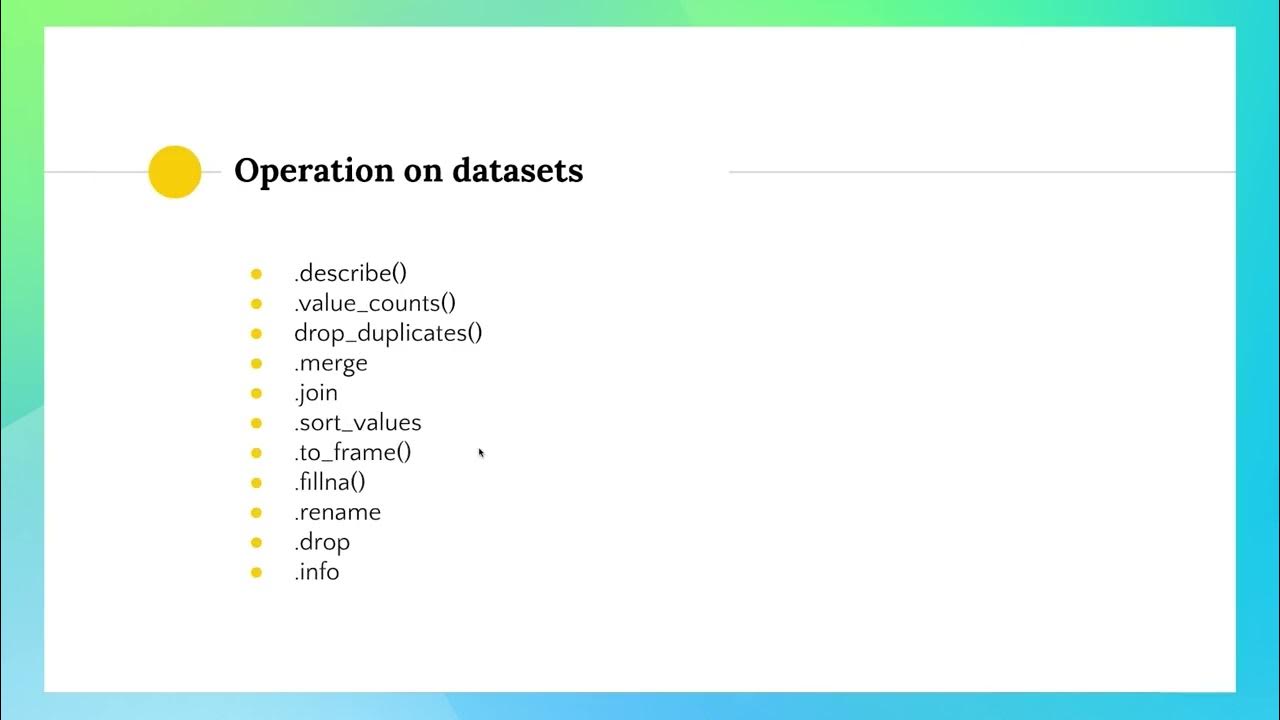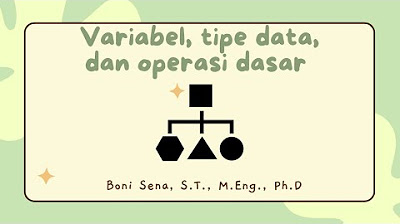Manipulação de Dados em Python/Pandas - #02 Tipos de Variáveis
Summary
TLDRIn this video, the instructor introduces the basics of data manipulation using the Pandas library, focusing on the importance of understanding different data types. The course covers numerical and categorical data, with a breakdown into discrete and continuous variables, as well as nominal and ordinal categories. The instructor emphasizes the need for proper categorization when working with datasets and explores the practical applications of these concepts, like grouping data and handling identifiers. The video offers a comprehensive overview of data types essential for anyone looking to dive deeper into data analysis and manipulation with Pandas.
Takeaways
- 😀 The video introduces the use of the Pandas library for data manipulation in the context of structured data analysis.
- 😀 Data is categorized into two main types: numerical data (used for quantitative analysis) and categorical data (used for qualitative analysis).
- 😀 Numerical data can further be divided into discrete data (integer counts) and continuous data (measured values such as height, weight, etc.).
- 😀 Discrete data involves integer numbers that can be counted (e.g., the number of rooms in a hotel), while continuous data can take any value in a range (e.g., height, weight).
- 😀 Categorical data is split into two categories: nominal (no inherent order, like hair color) and ordinal (with a defined order, like clothing sizes).
- 😀 Ordinal categorical data has a clear order between values (e.g., 'small', 'medium', 'large') unlike nominal data (e.g., hair color) which doesn't.
- 😀 A key concept in handling categorical data is identifiers, which refer to variables where each category is unique to an individual (e.g., ID numbers).
- 😀 Text data (e.g., movie descriptions, product reviews) is another important data type that can be manipulated or used to extract further information.
- 😀 Dates are another important data type, which can be converted into more useful attributes such as month or year for further analysis.
- 😀 The script stresses the importance of understanding how to categorize and handle data types effectively, as it influences the approach and analysis strategy.
Q & A
What are the two main categories of data types discussed in the script?
-The two main categories of data types discussed are numerical data and categorical data.
What is the difference between discrete and continuous numerical data?
-Discrete data consists of countable values, usually integers (e.g., number of rooms or births), while continuous data can take any value within a range and is typically used for measurements (e.g., height, weight, or time).
Can numerical data sometimes be treated as categorical? If so, how?
-Yes, numerical data can sometimes be treated as categorical. For example, months of the year or years in a dataset can be treated as categories or groups for analysis, even though they are represented numerically.
What is the difference between nominal and ordinal categorical data?
-Nominal data consists of categories with no inherent order (e.g., hair color or language), while ordinal data has a defined order (e.g., ratings like bad, average, good).
How are dates handled in pandas, and what can be done with them?
-Dates in pandas are typically represented as strings, but they can be converted into more useful variables such as the year, month, or day, which makes analysis easier.
What is an identifier in the context of categorical data, and why is it typically not useful for analysis?
-An identifier is a categorical variable where each category represents a unique individual or entity, such as an ID number. These variables are generally not useful for analysis, as they don't provide additional insights beyond identifying specific entities.
Why might categorical data be represented by numbers, and what should be considered when doing this?
-Categorical data is sometimes represented by numbers for convenience or modeling purposes, but these numbers should not be treated as having arithmetic significance. For instance, ratings (e.g., 0 = poor, 1 = good) represent categories, not numerical values for calculations.
Can monetary values, typically considered discrete, be treated as continuous data? Why?
-Yes, monetary values, despite being discrete (e.g., cents), are often treated as continuous because the difference between small units (like cents) becomes negligible when dealing with large amounts of money, allowing for continuous modeling.
What potential issues arise from using numerical scales for ratings, such as a 1-5 scale for customer satisfaction?
-The issue with numerical scales for ratings (e.g., 1-5) is that the difference between numbers may not accurately reflect the magnitude of the difference in quality. For instance, a rating of 4 might not be exactly twice as good as a rating of 2, making arithmetic operations like addition or averaging misleading.
How does the script recommend handling the categorization of months or years in a dataset?
-The script suggests that months or years in a dataset can be treated as categorical data, where each month or year represents a distinct category or group. However, depending on the context, they can also be treated numerically.
Outlines

This section is available to paid users only. Please upgrade to access this part.
Upgrade NowMindmap

This section is available to paid users only. Please upgrade to access this part.
Upgrade NowKeywords

This section is available to paid users only. Please upgrade to access this part.
Upgrade NowHighlights

This section is available to paid users only. Please upgrade to access this part.
Upgrade NowTranscripts

This section is available to paid users only. Please upgrade to access this part.
Upgrade Now5.0 / 5 (0 votes)





